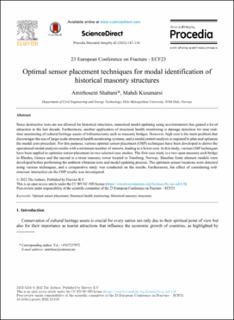| dc.contributor.author | Shabani, Amirhosein | |
| dc.contributor.author | Kioumarsi, Mahdi | |
| dc.date.accessioned | 2023-03-20T14:45:10Z | |
| dc.date.available | 2023-03-20T14:45:10Z | |
| dc.date.created | 2023-01-03T21:41:29Z | |
| dc.date.issued | 2022 | |
| dc.identifier.citation | Procedia Structural Integrity. 2022, 42 147-154. | en_US |
| dc.identifier.issn | 2452-3216 | |
| dc.identifier.uri | https://hdl.handle.net/11250/3059362 | |
| dc.description.abstract | Since destructive tests are not allowed for historical structures, numerical model updating using accelerometers has gained a lot of attraction in the last decade. Furthermore, another application of structural health monitoring is damage detection for near-real-time monitoring of cultural heritage assets of infrastructures such as masonry bridges. However, high cost is the main problem that discourages the use of large-scale structural health monitoring systems, and a modal pretest analysis is required to plan and optimize the modal tests procedure. For this purpose, various optimal sensor placement (OSP) techniques have been developed to derive the operational modal analysis results with a minimum number of sensors, leading to a lower cost. In this study, various OSP techniques have been applied to optimize sensor placement in two selected case studies. The first case study is a two-span masonry arch bridge in Rhodes, Greece and the second is a stone masonry tower located in Tønsberg, Norway. Baseline finite element models were developed before performing the ambient vibration tests and model updating process. The optimum sensor locations were detected using various techniques, and a comparative study was conducted on the results. Furthermore, the effect of considering soil structure interaction on the OSP results was investigated. | en_US |
| dc.language.iso | eng | en_US |
| dc.publisher | Elsevier | en_US |
| dc.relation.ispartofseries | Procedia Structural Integrity; | |
| dc.rights | Attribution-NonCommercial-NoDerivatives 4.0 Internasjonal | * |
| dc.rights.uri | http://creativecommons.org/licenses/by-nc-nd/4.0/deed.no | * |
| dc.title | Optimal sensor placement techniques for modal identification of historical masonry structures | en_US |
| dc.type | Peer reviewed | en_US |
| dc.type | Journal article | en_US |
| dc.description.version | publishedVersion | en_US |
| cristin.ispublished | true | |
| cristin.fulltext | original | |
| cristin.qualitycode | 1 | |
| dc.identifier.doi | https://doi.org/10.1016/j.prostr.2022.12.018 | |
| dc.identifier.cristin | 2100055 | |
| dc.source.journal | Procedia Structural Integrity | en_US |
| dc.source.volume | 42 | en_US |
| dc.source.issue | 42 | en_US |
| dc.source.pagenumber | 147-154 | en_US |

